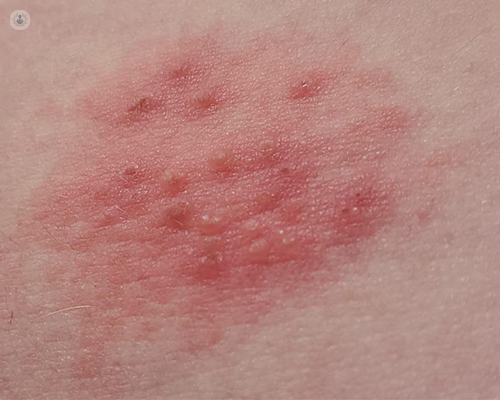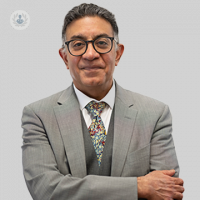Shingles (herpes zoster)
What is shingles?
Shingles is a viral infection that causes a tender and painful rash which most commonly presents either on the right or the left-hand side of the torso. You can also get shingles on your face, eyes and genitals.
Shingles is not life-threatening, but it can cause a lot of pain and discomfort.
What are the symptoms of shingles?
The first signs of shingles are usually pain felt in a particular area of skin, headache, and generally feeling unwell.
A few days after these symptoms, a rash will present. The shingles rash is red and blotchy, and appears on just one side of your body. The red blotches turn into small, itchy blisters that ooze fluid. Eventually, these blisters dry out and form little scabs. Even after the rash has gone, the area of skin affected can remain painful. The rash can take up to four weeks to heal.
Other symptoms experienced include:
- fatigue
- sensitivity to light
- fever
What causes shingles?
Shingles is caused by the varicella-zoster virus, which is the same virus that causes chickenpox. Anyone who has had chickenpox can develop shingles, as the virus stays in your nervous system, remaining dormant for years. If the virus reactivates, it moves along the nerve pathways resulting in shingles. Shingles is not contagious to people who have had chickenpox.
For people who have not had chickenpox, exposure to shingles can cause them to come down with the chickenpox. This can be dangerous, particularly in older people, pregnant women, newborns, and people with weakened immune systems.
How can shingles be prevented?
There are two vaccines that can help avoid shingles.
The first is the chickenpox vaccine, which is usually given to adults who have never had the chickenpox. This vaccine cannot guarantee you full protection from chickenpox, but it can significantly reduce your chances of contracting it.
The second preventative measure is the shingles vaccine. This is available in the UK to people over the age of 70. Even if you do contract shingles after the vaccine, the symptoms will be much milder. For people with shingles, they should avoid work or school until the rash scabs disappear.
How is shingles treated?
To treat shingles, there are some techniques to relieve the discomfort. These include:
- over-the-counter painkillers
- wearing loose-fitting clothing
- using cooling creams
- using a cool compress wrapped in a towel a few times a day
- colloidal oatmeal baths
There are also a couple of measures to avoid:
- do not let plasters or dressings stick to the rash
- do not use antibiotic cream, as this slows the healing process
Although there is no cure for shingles, you can take anti-viral medication to reduce the risk of complications and to help the healing process. For people experiencing severe pain, prescription painkillers will be considered.

Which specialist treats shingles?
Dermatologists are the medical specialists who typically treat shingles.
Is shingles contagious?
Unfortunately, shingles is indeed contagious. When a skin rash and blisters are present on one's skin, the shingles virus can spread from one person to another.
How is shingles transmitted from one person to another?
Shingles is transmitted from a contagious person with shingles to another individual through direct contact with the skin blister's fluid.
When is someone with shingles no longer contagious?
An individual who has contracted the shingles virus is not considered to be contagious before the skin rash appears on their skin, and can no longer spread it to other people once, and only once, the blisters on the skin have developed crusts.
What are the main risk factors?
Generally, any individual with a weakened immune system is at a high risk when it comes to contracting shingles.
People who fall into the following categories are also considered to be at a high risk of getting shingles:
- patients who have cancer
- people who have contracted HIV / AIDS
- people who are using steroids
- patients who are undergoing chemotherapy
- individuals who have undergone organ transplants
- people over the age of 50
- patients suffering from any chronic medical condition
Is it possible to get shingles more than once?
Although it is quite rare, people who have had shingles before can actually contract it again.
What is the most common complication of shingles?
Patients who contract shingles often experience extremely uncomfortable nerve pain, which is medically referred to as postherpetic neuralgia.
For how long can a person with shingles spread it?
Typically, the rash caused by shingles develops a crusty texture after roughly 10 days. After this period, a person can no longer transmit the virus.

